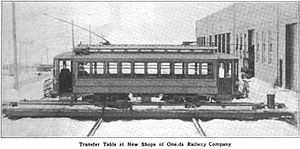Oneida Railway
| Oneida Railway | |
|---|---|
| Locale | Oneida, New York to Syracuse, New York |
| Dates of operation | 1907–1930 |
| Track gauge | 4 ft 8 1⁄2 in (1,435 mm) (standard gauge) |
The Oneida Railway, an interurban rail, was established in 1907 when the New York Central Railroad electrified 49 miles (79 km) of the West Shore Railroad between Syracuse, New York and Utica, New York.[1]
The interurban railroad used nontraditional third-rail pickup for power instead of the typical overhead catenary. In 1909 the system merged with the New York State Railways system which remained in business until 1930.[2]
The track was constructed in 1885 as part of the West Shore Railroad and eventually connected Oneida, New York with Syracuse, New York.[2]
History

Local trains ran on the streets in Oneida, but limiteds, which were faster and traveled longer distances, ran by the town to the south.[1]
All trains entered Syracuse, New York and Utica, New York on the street, using overhead trolley. A limited and local were run every hour until the late 1920s when the service scaled back and ran a single car each hour, except during the morning and evening rush periods.[1]
Electric rail
The company compared the merits of alternating current overhead equipment versus third-rail and the decision was made to install third-rail, direct-current system, due to the greater flexibility offered should it ever become necessary to make lateral extensions, install additional side tracks, switches, etc.[3]
The company had contracted with the Hudson River Electric Power Company for the delivery of three-phase current at a potential of 60,000 volts at the Clark Mills substation, about 7 miles (11 km) west of Utica. The power was generated from an auxiliary steam plant in that same city. Upon completion of the transmission lines, "current later will undoubtedly be taken from hydro-electric plants" owned by the company in eastern New York State.[3]
Construction
Work was started on May 15, 1906. The electrical equipment of the West Shore Railroad was installed by the Oneida Railway Company of Oneida, New York, a corporation organized "under the earlier railroad laws and having a more liberal charter than could be obtained were a new corporation to be organized at this time.[3] At that time, the terms under which the Oneida Railway Company would use the West Shore had not yet been agreed upon, but a contract had been made under which, after one year of operation, the companies in interest agree to execute an operating agreement.[3]
C. Loomis Allen was general manager of the construction project and W. J. Harvie was electrical engineer. Both worked for Utica and Mohawk Valley Railway Company of Utica and the Oneida Railway Company.[3]
Sub-divisions
For the purpose of construction, the line was split into four sub-divisions:[3]
- Genesee Street in Utica, New York to Vernon (town), New York grade - 11.3 miles (18.2 km)
- Vernon (town), New York to Lenox Avenue in Oneida, New York - 10 miles (16 km)
- Lenox Avenue in Oneida, New York to Chittenango, New York - 10.3 miles (16.6 km)
- Chittenango, New York to Syracuse, New York city limits - 12.5 miles (20.1 km)
Equipment and plants
The company built four substations in 1907 located 10.5 miles (16.9 km) apart in Clark Mills, Vernon, Canastota and Manlius Center. They were identical in construction and each was equipped with two 300-kilowatt rotary converters and the necessary equipment for transforming 60,000-volt three-phase current to direct current for distribution to the rail at 600 volts.[3]

The towers were built by the Archbold-Brady Company of Syracuse. In September 1906, there were 391 with "normal spacing" of 480 feet (150 m) in the planning stages. Most of the towers were 39 feet (12 m) high, however some were as tall as 63 feet (19 m).[3]
The company ordered 15 closed cars from the J. G. Brill Company. There were 49 feet (15 m) over the bumpers, 48 feet (15 m) over the crown pieces and 40 feet (12 m) over the body sheathing. The width of the cars was 8.5 feet (2.6 m). The body of the cars were divided into two compartments, the main compartment was 28.25 feet (8.61 m) long, with 19 double seats. The smoking compartment had 7 double seats. The cars were mounted on Brill 27E 2 trucks 5.5 feet (1.7 m) wheelbase spaced 29.5 feet (9.0 m) between truck centers, making a total wheelbase of 36 feet (11 m). The motor equipment consisted of four G.E. 73 motors per car. The control was the Sprague-General Electric multiple-unit type.[3]
Most of the cars used by the railway were multiple-unit interurbans until 1912 when the company bought a pair of steel cars fitted with parabolic ends.[1]
Vacation excursions
The road offered excursions to Sylvan Beach on Oneida Lake by June 1912. Travelers changed routes at Oneida Castle to New York, Ontario and Western Railroad "beach trains" which were the fastest and most direct route to the beach. Through tickets were sold at all stations for the "direct route."[4]
New York State railways
In 1909 the road merged with the New York State Railways system, which was formed from the merger of several interurban railways in Upstate New York. Streetcar service on the line remained in operation until December 31, 1930,[1] when it was abandoned in favor of buses and the track was reverted to freight service only.[2]
References
- ↑ 1.0 1.1 1.2 1.3 1.4 Hilton, George W. and Due, John. The Electric Interurban Railways in America. Stanford University Press, 1960, p.314. Retrieved March 4, 2011.
- ↑ 2.0 2.1 2.2 "New York Interurbans and Streetcar Railroads". American-rails.com, 2007. Retrieved February 16, 2011.
- ↑ 3.0 3.1 3.2 3.3 3.4 3.5 3.6 3.7 3.8 The Railway age, Volume 42. The Wilson Company: Chicago, September 7, 1906, p.295. Retrieved March 9, 2011.
- ↑ "Sylvan Beach - Oneida Railway Limeteds". Syracuse Herald (Syracuse, New York). June 25, 1912.